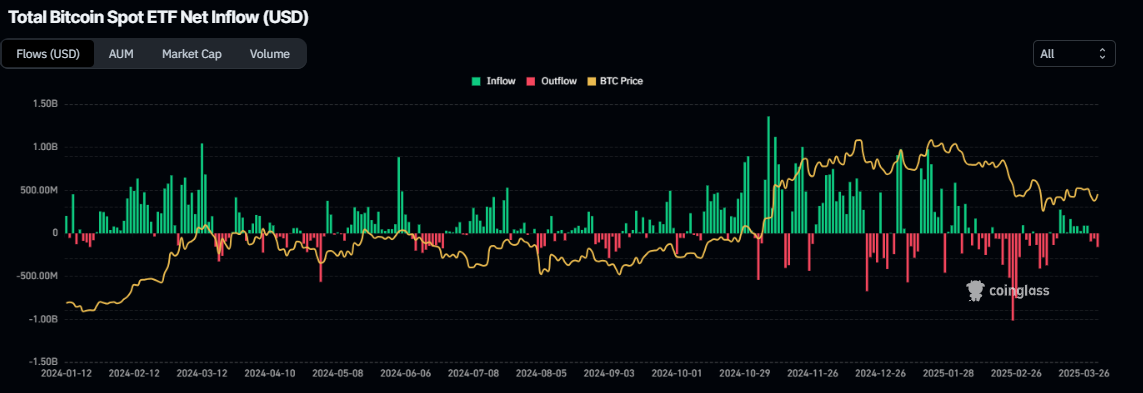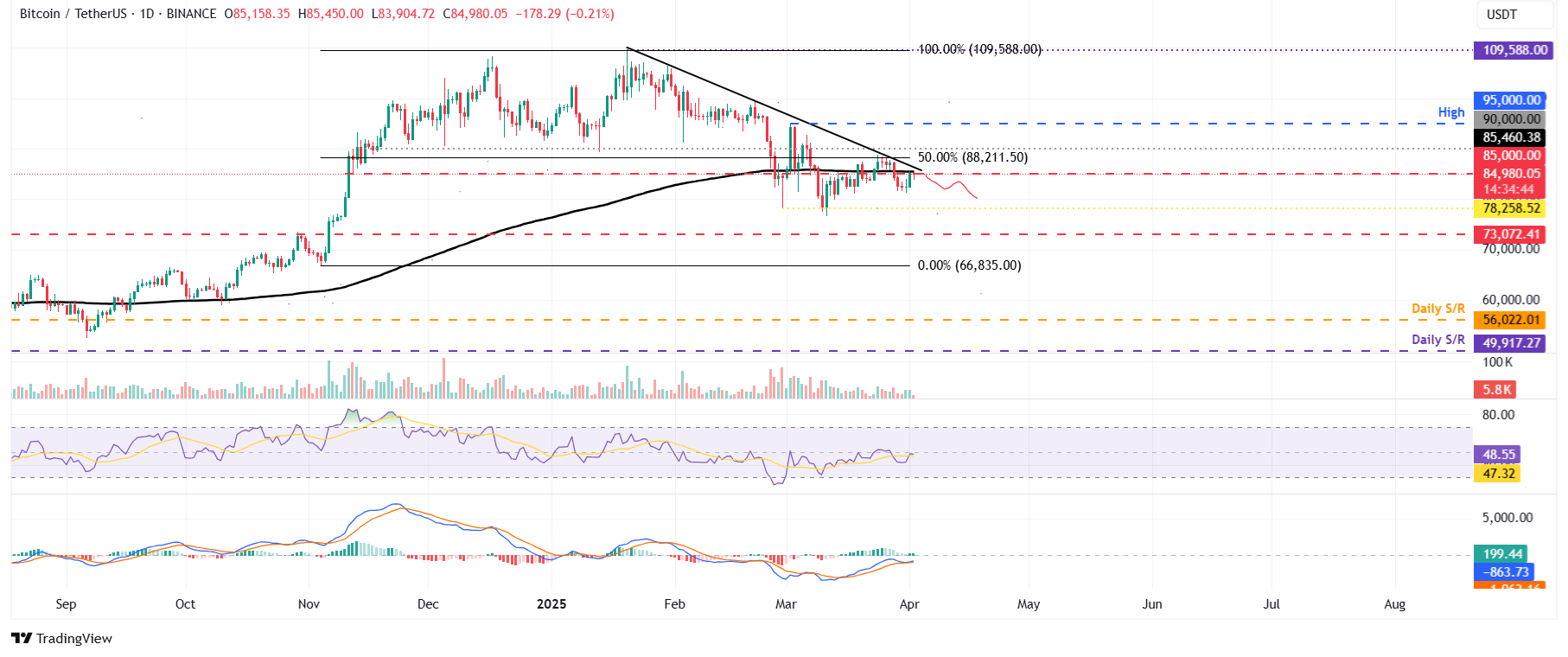- On Wednesday, Bitcoin’s price encounters a minor setback near the $85,000 resistance level following a 3.16% recovery the previous day.
- A report from K33 indicates that both Cryptocurrencies and Equities have significantly reduced risk leading up to Trump’s “Liberation Day.”
- Demand for US spot Bitcoin ETFs continues to decline with a $157.80 million outflow on Tuesday.
On Wednesday, Bitcoin (BTC) price is experiencing a minor rejection around the $85,000 resistance level after a 3.16% recovery the day prior. A K33 report emphasizes that Cryptocurrencies and Equities have substantially de-risked ahead of the “Liberation Day” proclaimed by Donald Trump. Meanwhile, the appetite for US spot Bitcoin Exchange Traded Funds (ETFs) is faltering, as evidenced by a notable outflow of $157.80 million on Tuesday.
Bitcoin risk reduction as Trump’s “Liberation Day” approaches
According to a detailed report from K33 titled ‘The Forgotten Reserve’, tariffs emerge as the dominant factor affecting market movements with “Liberation Day” approaching. Additionally, upcoming US jobs data could introduce further volatility. The report highlights that Cryptocurrencies and Equities have largely de-risked as they prepare for Trump’s significant tariff announcement on Wednesday.
The report notes that the anticipation of volatility from tariffs has made CME traders more cautious. The accompanying graph illustrates a retreat in traders’ willingness to assume risks, with futures premiums dropping to 5%, and CME open interest falling to its lowest in 11 months at 133,790 BTC.
“Contango has steepened after the expiry, but the surge—similar to February’s—does not indicate renewed interest from long traders, maintaining a risk-off sentiment,” states Vetle Lunde, Head of Research at K33.
Bitcoin Futures – Open Interest chart.
The report also reveals that amid the tariff discussions, federal agencies are expected to submit reports by Saturday, clarifying their authority to transition digital assets to the Strategic Bitcoin Reserve (SBR). This will provide clearer insights into the reserve’s initial composition and valuation.
“We anticipate the transfer of Bitfinex funds (94,636 BTC) to the exchange following this deadline,” remarks an analyst from K33 Research.
The analyst added, “Such a transfer may trigger volatility, especially since headlines reference the total US Government BTC holdings of approximately 200K BTC in connection with the SBR.” They predict BTC will continue to consolidate within a range of $75,000 to $88,000.
Declining institutional demand for Bitcoin as public companies increase interest
Institutional demand for Bitcoin is declining as the week progresses. As reported by Coinglass, Bitcoin spot ETF data showed an outflow of $157.80 million on Tuesday, following a smaller outflow of $60.60 million the day before. If this trend of outflows persists and escalates, Bitcoin’s price may drop further.


Total Bitcoin spot ETF netflow chart.
Despite the waning institutional interest, public companies are increasingly converting their balance sheets into Bitcoin reserves.
According to earlier reports, Gamestop (GME) has secured $1.5 billion in capital, potentially intending to allocate some of these funds towards enhancing its Bitcoin treasury. Metaplanet (MTPLF) has also acquired 160 BTC, raising its total holdings to 4,206 BTC. Additionally, Bitcoin mining firm MARA Holdings (MARA) is planning a $2 billion stock offering to acquire further Bitcoin, indicating a growing institutional interest in crypto assets.
This shift is generally seen as positive for Bitcoin’s price due to increased demand, a reduction in circulating supply, and a favorable market sentiment. If this trend continues, Bitcoin may experience more stable long-term price growth, although short-term volatility is expected as the market adapts to this surge in institutional engagement.
Bitcoin Price Projection: BTC nearing critical resistance at $85,000
Bitcoin’s price stabilized near $82,500 at the week’s outset on Monday and experienced a recovery of 3.16% the following day. As of Wednesday, it faces a minor rejection from the daily resistance level of $85,000. This resistance coincides with the 200-day Exponential Moving Average (EMA) and a descending trendline, marking it as a significant resistance zone.
The Relative Strength Index (RSI) on the daily chart measures 48 and trends downward following a rejection from its neutral point of 50, signaling slight bearish momentum. Should the RSI continue to decline, this could heighten bearish sentiment, leading to a notable drop in the BTC price. The Moving Average Convergence Divergence (MACD) lines are converging, suggesting indecision among traders.
If BTC continues to encounter resistance at the daily level of $85,000, it may see a decline, retesting its next support level at $78,258.

BTC/USDT daily chart.
Conversely, if BTC manages to recover and closes above the daily resistance of $85,000, it could extend its recovery rally towards the psychologically significant level of $90,000.
FAQs on Bitcoin, altcoins, and stablecoins
Bitcoin is the leading cryptocurrency by market capitalization, designed to function as a digital currency. This form of payment is not governed by any single individual, group, or entity, which eliminates the necessity for third-party involvement during financial transactions.
Altcoins refer to any cryptocurrency aside from Bitcoin, though some view Ethereum as a non-altcoin since both originate the forking process. If this is the case, Litecoin is considered the first altcoin, having forked from the Bitcoin protocol as an “enhanced” version of it.
Stablecoins are cryptocurrencies engineered to maintain a stable value, typically backed by reserves of the asset they represent. To achieve this stability, the value of a specific stablecoin is pegged to a commodity or financial instrument, like the US Dollar (USD), with its supply controlled by algorithms or demand. The primary objective of stablecoins is to facilitate entry and exit for investors seeking to trade and invest in cryptocurrencies. They also allow investors to preserve value since cryptocurrencies are generally volatile.
Bitcoin dominance reflects the ratio of Bitcoin’s market capitalization in comparison to the total market capitalization of all cryptocurrencies combined. This metric provides insight into Bitcoin’s popularity among investors. High BTC dominance is often observed prior to and during a bull market, where investors gravitate towards more stable cryptocurrencies with higher market caps like Bitcoin. Conversely, a decline in BTC dominance often indicates that investors are reallocating their capital and/or profits to altcoins in search of better returns, which can trigger significant altcoin rallies.
